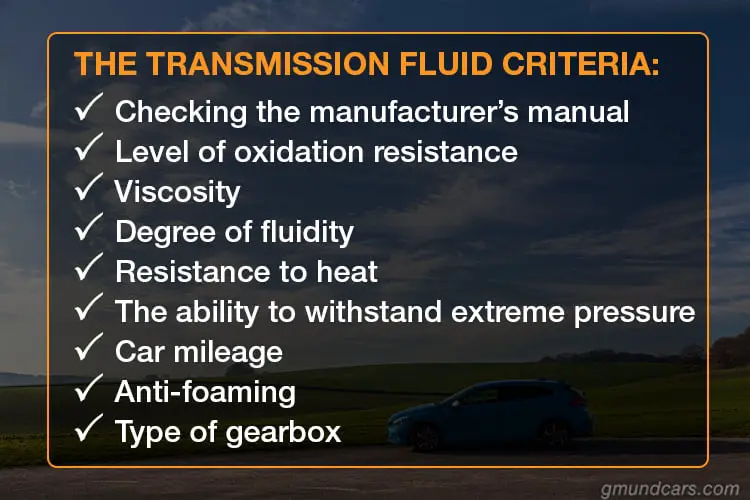As a car owner, you should often ponder the question, “Which type of transmission fluid should I use?” There are several kinds of transmission fluids, and the one you require is determined by your car’s make.
You should always ensure that the transmission fluid level is correct to avoid car complications. If the engine is revving while driving around corners, you are to get the transmission checked and change the transmission fluid. There are various factors you should consider while purchasing transmission fluid.
Transmission Fluid
Transmission fluid is found within the transmission. A fluid pan accommodates the transmission fluid. The new transmission fluid is dark red in color. With time it gets contaminated and tends to get darker. The transmission fluid can withstand temperatures up to 175 degrees F.
Roles Of Transmission Fluid
The fluid lubricates the mechanical parts in the transmission. Fluid pressure is maintained by the transmission fluid. Chances of rusting are lower due to the presence of transmission fluid. Smooth gear shifting is made possible by quality transmission fluid.
Transmission fluid acts as a coolant and thus maintains the temperature range in the transmission. The transmission fluid controls the rotational speed.
What Is Transmission Fluid Made Of?
Transmission fluid is made by ingredients that help improve lubrication and reduce the chances of rusting. Transmission fluid is a result of the crude oil refining process. Synthetic transmission fluid is manufactured through a combination of various chemicals. These chemicals are well mixed to achieve the feature of transmission fluid being less prone to oxidation.
Read more: What Does Transmission Fluid Smell Like?
What Transmission Fluid Do I Need?
Types Of Transmission Fluids For Different Car Brands
| Types of transmission fluid | Typical car brands |
|---|---|
| Dexron ATF | This is most suitable for car brands such as GMC cars, Cadillac, Pontiac, and trucks. |
| Mercon ATF | Mercon ATF is appropriate for car brands such as Ford, Mazda, and trucks. |
| ATF +3 & ATF +4 | Note that ATF +4 is a synthetic fluid. ATF +4 is compatible with ATF +3 backward. This synthetic fluid is suitable for Dodge, Jeep, Trucks, Mopar, and Chrysler cars. |
| Z-1 & DW-1 ATF | These two types of transmission fluids are most appropriate for Honda cars and Acura vehicles. |
| Dexron-III & Dexron-II | Most Nissan cars and trucks use Dexron-II as the default transmission fluid type. Most Subaru cars are compatible with the Dexron-III. Toyota and Lexus cars make use of this Dexron-III as well. |
| SP ATF | SP ATF is a synthetic transmission fluid with very low viscosity. SP ATF is most compatible with Mitsubishi, Hyundai, Kia cars and trucks. |
Read more: Dirty Transmission Fluid: Signs And Causes
The Transmission Fluid Criteria
One should follow up criteria while looking for transmission fluid. The factors to consider include:

Checking The Manufacturer’s Manual
The driver should check out the manual to get the type of transmission fluid that is appropriate.
Level Of Oxidation Resistance
You should find a transmission fluid that does not get oxidized easily. Transmission failure may happen due to the oxidation of the transmission fluid.
Viscosity
It is the measurement of how thick the fluid is. You have to ensure that you get a transmission fluid that is not too thick to avoid slow or sluggish operation.
Low viscosity
It lubricates all the parts of the transmission easily and quickly. The operation is smooth since the fluid is not too thick to flow. The highly recommended viscosity level is 0W/5 or 5W/10. Inner resistance loss is low in transmission fluid with low viscosity.
Fuel consumption is low when this type of transmission fluid is in use.
High viscosity
In addition, thicker transmission fluid results in higher fuel consumption. More energy is required to make the fluid flow since it is too thick causing sluggish operation. The higher the viscosity, the better the resistance to shock damage in the gears.
Degree Of Fluidity
This is how the transmission fluid performs in cold weather or low temperatures. Transmission fluid should be able to withstand low temperatures.
Note that low temperatures may thicken the transmission fluid and reduce lubrication.
Read more: Low transmission fluid: Symptoms, causes, and repair guide
Resistance To Heat
The transmission fluid is supposed to withstand the heat produced by the friction in the gearbox.
Since the transmission fluid acts as a coolant, it should transfer heat away from the mechanical parts.
The Ability To Withstand Extreme Pressure
Ideally, the transmission fluid manages the pressure within the transmission.
In the transmission, the work is under high pressure.
Car Mileage
High mileage
Vehicles with high mileage usually last longer. They lubricate themselves therefore no need of changing the transmission fluid frequently.
Low mileage
Cars with low mileage have to change the transmission fluid frequently.
Anti-foaming
Air is kept out of reach of the transmission fluid to avoid malfunctions. Note that air interferes with lubrication. Therefore, the anti-foaming property caters to this problem.
Type Of Gearbox
Manual gearbox

Lots of friction is produced causing more heat production. The transmission fluid should be able to withstand the heat. The fluid’s purpose is to transfer the heat away from the moving mechanical parts since it is a coolant.
As a car driver, you should be able to differentiate the transmission fluid for your manual gearbox.
In a manual transmission, you are expected to change the fluid after thirty thousand to sixty thousand miles.
Automatic gearbox

There are more moving parts in the automatic gearbox thus more lubrication is needed.
The transmission fluid should be of lower viscosity to be able to lubricate the moving parts efficiently. The more the moving parts the more friction and the more heat produced. Resistance heat is a factor to consider while purchasing transmission fluid for your automatic gearbox.
It is essential to know that detergent can be added to the transmission fluid to keep the spaces clean between the mechanical parts.
Transmission fluid is changed after every 60,000 to 100,000 miles for automatic transmission.
Read more: How often to change transmission fluid
FAQs
1. What happens if you put the wrong type of transmission fluid in your car?
When the wrong transmission fluid type is put in your car, there are high chances to experience overheating and transmission failure. Fluid flashing may not help reverse the damage made.
2. Do certain cars need certain transmission fluids?
Certain transmission fluids are not compatible with various transmission types. As a driver, you should go through the car manufacturer manual to know the kind of transmission fluid your car requires.
3. Is it OK to mix transmission fluids?
Some transmission fluid types can be mixed and still work smoothly. For example, synthetic transmission fluid and conventional transmission fluid, and synthetic and mineral-based transmission fluids can be mixed and be compatible.
4. What kind of transmission fluid does TOYOTA use?
Toyota car makes are compatible with synthetic automatic transmission fluid.